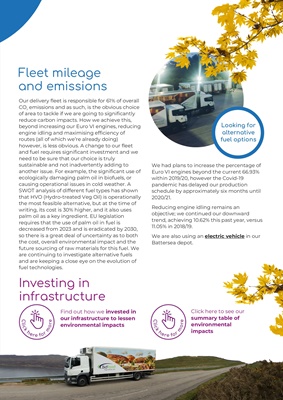
Fleet mileage and emissions
Our delivery fleet is responsible for 61% of
overall CO2 emissions and as such, is the
obvious choice of area to tackle if we are going
to significantly reduce carbon impacts. How we
achieve this, beyond increasing our Euro VI
engines, reducing engine idling and
maximising efficiency of routes (all of which
we're already doing) however, is less obvious.
A change to our fleet and fuel requires
significant investment and we need to be sure
that our choice is truly sustainable and not
inadvertently adding to another issue, for
example the significant use of ecologically
damaging palm oil in biofuels, or causing
operational issues in cold weather. A SWOT
analysis of different fuel types has shown that
HVO (Hydro-treated Veg Oil) is operationally
the most feasible alternative, but at the time of
writing, its cost is 30% higher, and it also uses
palm oil as a key ingredient. EU legislation
requires that the use of palm oil in fuel is
decreased from 2023 and is eradicated by
2030, so there is a great deal of uncertainty as
to both the cost, overall environmental impact
and the future sourcing of raw materials for this
fuel. We are continuing to investigate
alternative fuels and are keeping a close eye
on the evolution of fuel technologies.
We had plans to increase the percentage of
Euro VI engines beyond the current 66.93%
within 2019/20, however the Covid-19
pandemic has delayed our production
schedule by approximately six months until
2020/21.
Reducing engine idling remains an objective;
we continued our downward trend, achieving
10.62% this past year, versus 11.05% in
2018/19.
We are also using an electric vehicle in our
Battersea depot.
Investing in infrastructure
Click here to find out
how we invested in our
infrastructure to lessen
environmental impacts
TWO TABLES AND A
GRAPH TO GO ON HERE
[1] CO2e per case went up in 2019/20 due to a 19%
drop in volume against the previous year due to
Covid-19.
[1] Water consumption figures impacted by estimated
consumption versus actual consumption re-calibration
reflected in 2019/20 invoices.
[1] This huge rise is due to 400+ vans hired or leased
from sister companies for delivery of care packs to
residential addresses.
[1] Far higher than normal due to Covid-19 care pack
operation.